A new species of the genus Tuckerella (Acari: Trombidiformes: Tuckerellidae) from Iran
Safdarkhani, Hamid Khadem1 and Asadi, Mahdieh2
1Department of Plant Protection, College of Agriculture, Shahid Bahonar University of Kerman, Kerman, Iran.
2✉ Department of Plant Protection, College of Agriculture, Shahid Bahonar University of Kerman, Kerman, Iran.
2018 - Volume: 58 Issue: 1 pages: 15-30
https://doi.org/10.24349/acarologia/20184224ZooBank LSID: 90556659-7015-4D66-92E3-37C7E6C58D1A
Keywords
Abstract
The Tuckerellidae, or peacock mites, is a relatively small family of the Tetranychoidea, with just one genus and 28 species (Krantz & Walter, 2009). These attractive mites are orange to red in color, ornamented with rows of white, palmate, oval or circular setae and have a row of 4 to 7 pairs of long, whip-like caudal setae (Meyer & Ueckermann, 1997). Tuckerellid species are described from the following eight zoogeographic regions: Oriental (11 species), Eastern Palearctic (four species), Nearctic (three species), Australian (three species), Afrotropical (two species), Pacific Islands (two species), Neotropical (two species) and Western Palearctic (one species). To date, three species were recorded from Iran: T. flabellifera Miller, 1964, T. hypoterra McDaniel & Morihara, 1975 and T. japonica Ehara, 1975. According to Beyzavi et al. (2013), Kamali (1989) was the first to report tuckerellids from Iran namely, Tuckerella sp. near. knorri Baker & Tuttle, 1975 (Beyzavi et al. 2013).
Herein, we describe the first new species from Iran, Tuckerella parsi n. sp. from Tamarix aphylla (Tamaricaceae).
Leaves and twigs infested with mites were collected, placed into plastic bags and transferred to the laboratory. Samples were washed in a solution of a commercial detergent (5%). This solution was filtered by overlapping two sieves with different mesh sizes (16 Mesh; 400 Mesh). Mites retained on the smaller mesh sieve were washed with 70% ethanol into a petri dish. Peacock mites were collected from the ethanol solution under a stereomicroscope, cleared with lactic acid (at 45°C in oven for two days) and mounted in Hoyer’s medium.
The terminology and abbreviations used for the descriptions of the new species follow those of Lindquist (1985). Leg chaetotaxy also follows Quiros-Gonzalez & Baker (1984), as improved upon by Lindquist (1985), and is presented on the figures; setal counts include all phaneres, i.e., solenidia and eupathidia are included. Measurements were performed using a DINO-EYE® soft imaging system and are given in micrometers (μm) for the holotype and as a range for paratypes in parentheses. The drawings were made by using a drawing tube attached to an Olympus® Phase Contrast Research Microscope.
Abbreviations
ACASI: Acarological Collection, Acarological Society of Iran (ASI), Department of Plant Protection, Faculty of Agriculture, University of Tehran, Karaj, Iran
SBUC: Collection of the Acarology Laboratory, Shahid Bahonar University of Kerman, Kerman, Iran
Diagnosis as of Beard & Walter, 2005
ZOOBANK: ED651AFF-6777-4930-83FB-51501768C3BA ![]()
Type material examined — Holotype female (SBUC) and three female paratypes (SBUC), five female tritonymphs (4 SBUC, 1 ACASI), five protonymphs (4 SBUC, 1 ACASI), four males (3 SBUC, 1 ACASI) ex Tamarix aphylla (Tamaricaceae), Iran: Kerman Province, Manujan, 27°19’N 57°29’E, 18 October 2014, coll. H. Khadem Safdarkhani.
Adult female: Rostrum very long, passing base of tarsi I, prodorsum and most dorsal hysterosoma covered with closed cells; prodorsal setae palmate (v1 dissimilar to other prodorsal setae) with rounded tips and prodorsal setae v1 longer than v2; setal row H with six pairs of flagellate setae and two pairs of short palmate setae (h1 shorter than h6); setae h3 shorter than other flagellate setae; opisthosomal setae f1 and f2 subequal; c4 about two thirds the length of distance between c4–sc2; femur and genu of leg III each with three setae (two ventral and one dorsal). All setae on tarsi I – IV except setae p ζ and both ft barbed.
FEMALE (Figs. 1–3)(n=4). Body oval, orange in color, length (vi–h1) 271 (268 – 273), width (c5–c5) 186 (185 – 191).
Gnathosoma — Rostrum long, passing base of tarsi I, with long ventral setae m. Palp setal formula: 0–0–1–3–4, genual seta barbed, tibial setae slender, tarsus with two eupathidia, one solenidion and one tactile seta (Fig. 1C). Peritreme anastomosed distally (Fig. 1E).
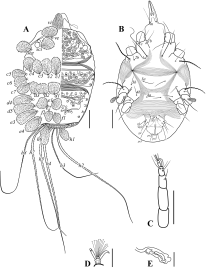


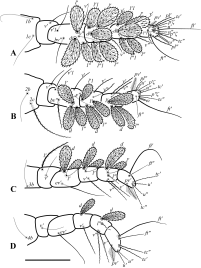


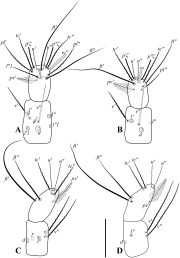


Dorsum (Fig. 1A) — Dorsal shields covered with cells forming reticulate pattern. Dorsal setae expanded, leaf-like, toothed margins, except setae vi smooth, without barbules. Hysterosomal setae, c1–7, d1–5, e1–4, h1 and h6, subcircular, subrectangular. Lengths of dorsal setae: vi 45 (43 – 48), ve 32 (32 – 34), sci 37 (35 – 38), sce 42 (43 – 47), c1 47 (44 – 47), c2 45 (44 – 46), c3 42 (41 – 44), c4 39 (38 – 41), c5 39 (39 – 42), c6 39 (37 – 40), c7 39 (38 – 40), d1 34 (33 – 37), d2 32 (30 – 33), d3 37 (35 – 38), d4 58 (56 – 59), d5 61 (59 – 62), e1 29 (28 – 30), e2 32 (31 – 34), e3 63 (60 – 64), e4 55 (54 – 58), f1 28 (27 – 28), f2 28 (27 – 29); posterior margin of opisthosoma with six pairs of long flagellate setae (h2, h3, h4, h5, h7, h8) and two pairs of expanded setae (h1 and h6), same as dorsal setae; lengths: h1 42 (40 – 43), h2 358 (353 – 361), h3 229 (225 – 234), h4 351 (346 – 354), h5 316 (312 – 319), h6 53 (51 – 56), h7 337 (334 – 341), h8 297 (294 – 302).
Venter (Fig. 1B) — Ventral striae pattern: longitudinal striae laterad setae 1a but smooth medially, band of transverse striae between seta 1a and 3a; longitudinal striae on both sides of body between coxa II and III, smooth around setae 3a and 4a; striae on rest of venter up to genital plate transverse, striae on pregenital area surrounding setae ag1 longitudinal to oblique, genital and pseudanal region smooth. Pregenital setae two pairs (ag1–2), genital setae four pairs (g1–4) and pseudanal setae three pairs (ps1–3), pregenital, genital and anal plate difficult to discern. Setae 1a more than two and four times as long as 3a and 4a, respectively; setae 2c thick, barbed; setae ps2 barbed, all other setae smooth. Length of ventral setae: 1a 86 (83 – 87), 1b 27 (29 – 31), 1c 25 (25 – 28), 2b 40 (38 – 41), 2c 67 (66 – 70), 3a 30 (28 – 30), 3b 22 (22 – 24), 3c 5 (5 – 6), 4a 18 (17 – 19), 4b 18 (18 – 20), 4c 6 (5 – 6), ag1 19 (19 – 20), ag2 18 (17 – 19), g1 12 (11 – 12), g2 11 (10 – 11), g3 23 (22 – 24), g4 23 (22 – 25), ps1 11 (11 – 12), ps2 16 (15 – 17), ps3 33 (32 – 35).
Legs (Figs. 1D, 2A–D, 3A–D) — Tarsal claws claw-like and empodium pad-like with tenent hairs. Setation of legs I – IV: coxae 2(1b,1c) – 2(2b,2c) – 1(3b) – 1(4b); trochanters 1(v') – 1(v') – 1(v') – 1(v'); femora 7(d, v', v'', v'1, bv", l', l'') – 7(d, v', v'', v'1, bv", l', l'') – 3(ev', d, l') – 1(ev'); genua 7(d, v', v", l', l", l'1, l"1) – 6(d, v', v", l', l", l'1) – 3(d, v', l') – 2(d, v'); tibiae 8(d, v', v", l', l", l'1, l"1, φ) – 5(d, v', v", l', l") – 5(d, v', v", l', l") – 4(d, v', v", l"); tarsi 14(pv', l''1, pl', pl'', ft', ft", ω', ω", u', u", p'ζ, p"ζ, tc', tc") – 11(pv', pl'', ft', ft", ω'', u', u", p'ζ, p"ζ, tc', tc") – 7( pv', ft', ft", u', u", tc', tc") – 7(pv', ft', ft", u', u", tc', tc").
MALE (Figs. 4–6)(n=4). Body oval, length (vi–h1) 232 (226 – 233), width (c5–c5) 149 (149 – 156). Gnathosoma and palps similar to female, (Fig. 4C).
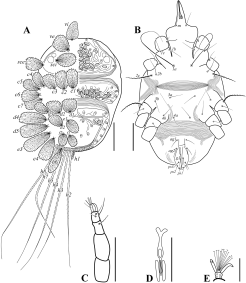


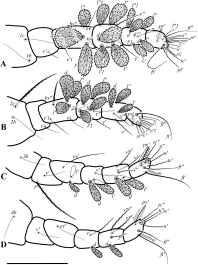


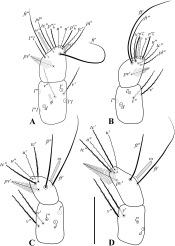


Dorsum (Fig. 4A) — Sculpturing and setation similar to female, except setae h1 much smaller. Lengths of dorsal setae: vi 35 (34 – 38), ve 34 (35 – 37), sci 31 (32 – 34), sce 34 (33 – 36), c1 40 (39 – 41), c2 37 (35 – 38), c3 35 (35 – 37), c4 32 (30 – 33), c5 35 (33 – 36), c6 34 (34 – 37), c7 33 (32 – 35), d1 28 (27 – 29), d2 31 (29 – 32), d3 32 (31 – 33), d4 46 (44 – 47), d5 50 (49 – 52), e1 28 (28 – 30), e2 31 (30 – 32), e3 57 (56 – 59), e4 46 (44 – 47), f1 28 (26 – 29), f2 27 (25 – 27); posterior margin of opisthosomal setae same as female. Their lengths as follows: h1 23 (22 – 23), h2 295 (289 – 297), h3 248 (241 – 247), h4 275 (268 – 276), h5 282 (279 – 287), h6 25 (24 – 25), h7 268 (262 – 269), h8 252 (246 – 254).
Venter (Fig. 4B) — Ventral striae pattern similar to female, except lacking striae laterad setae 1a and band of transverse striae between setae 3a and 4a. Pregenital setae two pairs (ag1–2), genital setae one pair (g2) and pseudanal setae three pairs (ps1–3). Setae 2c stout, barbed all other setae smooth. Length of ventral setae: 1a 64 (62 – 66), 1b 20 (18 – 21), 1c 19 (20 – 22), 2b 17 (16 – 19), 2c 48 (45 – 49), 3a 17 (16 – 19), 3b 14 (12 – 15), 3c 8 (8 – 9) 4a 18 (17 – 18), 4b 17 (16 – 18), 4c 8 (8 – 9), ag1 13 (12 – 13), ag2 15 (12 – 14), g2 11 (10 – 11), ps1 8 (7 – 8), ps2 9 (8 – 9), ps3 11 (10 – 12). Setae 1a more than three times as long as 3a and 4a. Aedeagus (Fig. 4D) short, thick.
Legs (Figs. 4E, 5A–D, 6A–D) — Tarsal claws claw-like and empodium with tenent hairs. Setal formula (coxa to tarsus) the same as female, but tarsus III and IV with one extra solenidion.
FEMALE TRITONYMPH (Figs. 7A–C, 8–9)(n=5). Body length (vi–h1) 255 (248 – 257), width (c5–c5) 169 (170 – 174). Gnathosoma and palps: rostrum same as female (Fig. 7B).
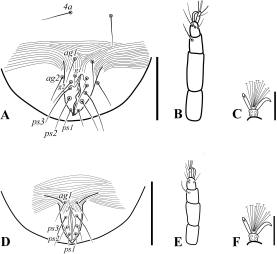





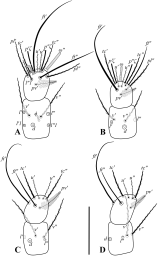


Dorsum — Cuticle pattern same as female. Lengths of dorsal setae: vi 47 (48 – 51), ve 33 (32 – 35), sci 30 (30 – 32), sce 32 (30 – 33), c1 19 (18 – 21), c2 21 (20 – 21), c3 25 (24 – 27), c4 34 (32 – 35), c5 44 (43 – 46), c6 49 (49 – 52), c7 49 (50 – 52), d1 32 (31 – 34), d2 31 (30 – 32), d3 31 (30 – 33), d4 48 (46 – 49), d5 54 (53 – 57), e1 22 (21 – 24), e2 23 (24 – 27), e3 47 (47 – 50), e4 49 (48 – 51), f1 28 (26 – 29), f2 27 (25 – 29); posterior margin of opisthosomal setae same as female, their lengths as follows: h1 33 (32 – 34), h2 297 (291 – 298), h3 205 (195 – 204), h4 257 (251 – 259), h5 285 (279 – 288), h6 44 (43 – 47), h7 283 (278 – 285), h8 292 (284 – 291).
Venter (Fig. 7A) — Ventral striae pattern the same as female except lacking smooth area around 3a (covered with transverse striae around 3a in female) and setae 1a (two times and four times) longer than 3a and 4a, respectively. Pregenital setae two pairs (ag1–2), genital setae two pairs (g1–2) and pseudanal setae three pairs (ps1–3). Setae 2c stout, barbed; all other setae smooth. Length of ventral setae: 1a 76 (75 – 78), 1b 31 (32 – 35), 1c 27 (26 – 28), 2b 33 (32 – 35), 2c 44 (42 – 46), 3a 23 (23 – 24), 3b 21 (20 – 22), 4a 27 (25 – 28), 4b 22 (22 – 24), ag1 19 (19 – 20), ag2 21 (22 – 25), g1 9 (9 – 10), g2 26 (24 – 27), ps1 19 (18 – 20), ps2 27 (25 – 28), ps3 30 (28 – 31).
Legs (Figs. 7C, 8A–D, 9A–D) — Tarsal claws, empodium, and setal count the same as female.
PROTONYMPH (Figs. 7D–F, 10–11)(n=5). Body length (vi–h1) 178 (174 – 179), width (c5–c5) 136 (135 – 140). Gnathosoma and palp same as female. (Fig. 7E).
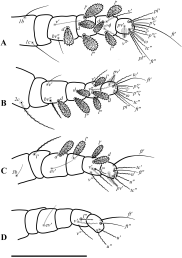





Dorsum — Cuticle pattern same as female. Lengths of dorsal setae: vi 38 (36 – 41), ve 24 (22 – 25), sci 25 (24 – 25), sce 31 (29 – 31), c1 22 (21 – 24), c2 24 (24 – 26), c3 20 (21 – 22), c4 19 (18 – 21), c5 32 (30 – 33), c6 37 (35 – 37), c7 40 (41 – 43), d1 20 (18 – 21), d2 18 (17 – 20), d3 23 (20 – 22), d4 33 (32 – 35), d5 39 (37 – 40), e1 19 (17 – 19), e2 20 (20 – 21), e3 34 (33 – 35), e4 32 (32 – 33), f1 18 (17 – 19), f2 17 (17 – 18); posterior margin of opisthosomal setae same as female, lengths as follows: h1 24 (23 – 26), h2 214 (202 – 209), h3 115 (112 – 116), h4 161 (151 – 159), h5 188 (182 – 190), h6 34 (33 – 36), h7 163 (155 – 163), h8 190 (185 – 192).
Venter (Fig. 7D) — Ventral striae pattern: the same as female Pregenital setae one pair (ag1), pseudanal setae three pairs (ps1 – 3), setae 2b, 4b, 4a, ag2, g1, g2, g3 and g4 absent. Setae 2c stout, barbed; all other setae smooth. Length of ventral setae: 1a 61 (56 – 60), 1b 22 (22 – 23), 1c 20 (18 – 21), 2c 30 (28 – 32), 3a 21 (21 – 23), 3b 15 (12 – 14), ag1 18 (13 – 16), ps1 12 (11 – 12), ps2 16 (15 – 17), ps3 28 (26 – 29). Setae 1a more than two times as long as 3a.
Legs (Figs. 7F, 10A–D, 11A–D) — Tarsal claws claw-like and empodium with tenent hairs.
Setation of legs I – IV: coxae 2(1b,1c)–1(2c)–1(3b)–0; trochanters 0–0–1(l')–0; femora 3(d, v', bv")–3(d, v', bv")–2(ev', d)–1(ev'); genua 3(d, l', l")–2(d, l")–1(l')–0; tibiae 6(d, v', v", l', l", φ) – 5(d, v', v", l', l") – 5(d, v', v", l', l") – 3(v', v", l"); tarsi 12(pv', pl', pl'', ft', ft", ω", u', u", p'ζ, p"ζ, tc', tc") – 11(pv', pl'', ft', ft", ω'', u', u", p'ζ, p"ζ, tc', tc") – 7( pv', ft', ft", u', u", tc', tc") – 4(ft', ft", u', u").
This species resembles T. channabasavannai Mallik & Kumar, 1992, T. equalis Chaudhri, 1971, T. indica Prasad, 1973 and T. knorri Baker & Tuttle, 1975 due to the following character states: six pairs of flagellate caudal setae on opisthosoma, dorsal pattern reticulated, setae f1–2 with rounded tips and subequal in length in female, and prodorsal setae vi and ve of different lengths. Tuckerella parsi differs from T. channabasavannai by having: subequal e4 and h6 (e4 massive compared to h6 in T. channabasavannai), setae h1 smaller than h6 (subequal in T. channabasavannai), large d1–3, e1–2, f1–2, h1 (much smaller in T. channabasavannai), solenidion Ta I ω' much smaller than ω'' (subequal in T. channabasavannai), and solenidion Ti I ϕ very small (much longer, almost reaching tarsus in T. channabasavannai). We also note an error in the key of Meyer & Ueckermann (1997): in couplet 19, T. channabasavannai has solenidia of subequal length, differing by only a few micrometres, so should instead key to T. equalis Chaudhri, 1971. These species are remarkably similar and it seems likely that T. channabasavannai is a junior synonym of T. equalis. The same may apply to T. indica, which is also remarkably similar to these two species. Neither Prasad (1973) nor Mallik & Kumar (1992) compared their species to that of Chaudhri (1971).
Tuckerella parsi is most similar to T. knorri by also having the proximal solenidion on tarsus I much shorter than the distal solenidion. It differs by having: setae h6 large and subequal with setae e4 in T. parsi (setae h1 small, much smaller than e4 in T. knorri); setae h1 smaller than h6, but broad and palmate (setae h1 the same size as h6, as a short thickened seta in T. knorri); and generally many setae are larger in T. parsi than in T. knorri (for example, setae c1 – 4 are elongate versus orbicular in T. knorri).
The authors wish to thank Dr. Owen D. Seeman for his helpful comments on leg setal designations in this manuscript.
Baker E.W., Tuttle D.M. 1975 — A new species of Tuckerella (Acarina: Tuckerellidae) from Thailand — U.S. Dept. Agr. Coop. Econ. Inst. Rept., 25(17): 337-340.
Beard J.J., Walter D.E. 2005 — A new species of Tuckerella (Prostigmata: Tetranychoidea: Tuckerellidae) from Australia with descriptions of all stages and a discussion of the tritonymphal stage — Acarologia, 45: 49-60.
Beyzavi G., Ueckermann E.A., Faraji F., Ostovan H. 2013 — A catalog of Iranian prostigmatic mites of superfamilies Raphignathoidea & Tetranychoidea (Acari) — Persian J. Acarol., 2(3): 389-474.
Chaudhri W. M. 1971 — Four new species of the genus Tuckerella from Pakistan. Pakistan J. Zool., 3(1): 79-86.
Ehara S. 1975 — Description of a new species of Tuckerella from Japan (Acarina: Tuckerellidae) — Internat. J. Acarol., 1(2): 1-5. doi:10.1080/01647957508683741 ![]()
Kamali K. 1989 — A checklist of plant mites (Acari) of Khuzestan, Southwestern Iran —Sci. J. Agric., 13: 73-83 (In Persian with English abstract).
Krantz G.W., Walter D.E. 2009 — A Manual of Acarology. Third Edition — Texas Tech University Press; Lubbock, Texas, 807 PP.
Lindquist E.E. 1985 — External anatomy. In: Helle, W. & Sabelis, M.W. (Eds.), Spider mites: their Biology Natural Enemies and Control — Amsterdam, Elsevier Science Publishers B. V., 1A: 3-28.
Magdalena K.P., Meyer S., Ueckermann E.A. 1997 — A review of some species of the families Allochaetophoridae, Linotetranidae and Tuckerellidae (Acari: Tetranychoidea) — Internat. J. Acarol., 23(2): 67-92. doi:10.1080/01647959708683103 ![]()
Mallik B., Kumar M.H. 1992 — Tuckerella channabasavannai sp. nov. (Acari: Tuckerellidae) from India — Internat. J. Acarol., 18(2): 117-119. doi:10.1080/01647959208683941 ![]()
McDaniel B., Morihara D.K., Lewis J.K. 1975 — A new species of Tuckerella from South Dakota and a key with illustrations of all known described species — Acarologia, 17(1): 274-283.
Meyer M.K.P. (Smith), Ueckermann E.A. 1997 — A review of some species of the families Allochaetophoridae, Linotetranidae and Tuckerellidae (Acari: Tetranychoidea) — Internat. J. Acarol., 23(2): 67-92. doi:10.1080/01647959708683103 ![]()
Miller L.W. 1964 — A new species of Tuckerella (Acarina: Tetranychoidea: Tuckerellidae) from Tasmania — Pap. Proc. Roy. Soc. Tasmania, 98: 79-84.
Prasad V. 1973 — A new species of Tuckerella (Acarina: Tuckerellidae) from India — Acarologia, 15: 237-239.
Quiros-Gonzalez M.J., Baker E.W. 1984 — Systematics and taxonomy of Acari. 5.5 Idiosomal and leg chaetotaxy in the Tuckerellidae Baker & Pritchard; ontogeny and nomenclature. In: Griffiths, D.A. and C.E. Bowman (eds.). Acarology 6, vol. 1 — Chichester, Ellis Horwood Ltd.: 166-173.
Womersley H. 1940 — Studies in Australian Acarina Tetranychidae and Trichadenidae — Trans. Roy. Soc. of S. Austr., 64: 233-265.



2017-04-20
Date accepted:
2017-07-25
Date published:
2017-12-21
Edited by:
Faraji, Farid

This work is licensed under a Creative Commons Attribution 4.0 International License
2018 Safdarkhani, Hamid Khadem and Asadi, Mahdieh
Download the citation
RIS with abstract
(Zotero, Endnote, Reference Manager, ProCite, RefWorks, Mendeley)
RIS without abstract
BIB
(Zotero, BibTeX)
TXT
(PubMed, Txt)



